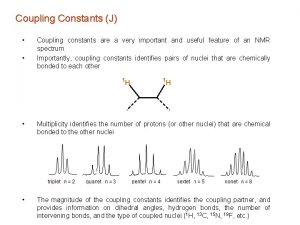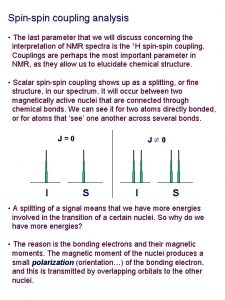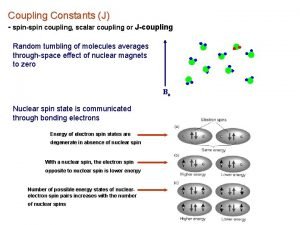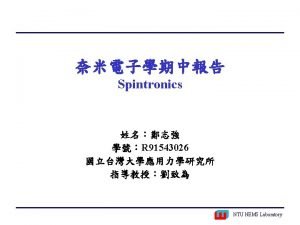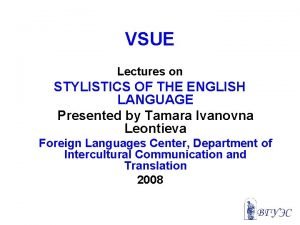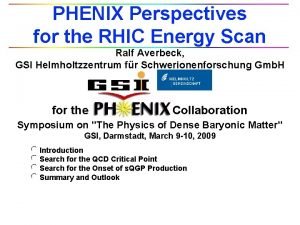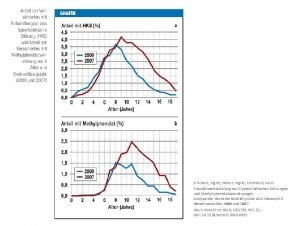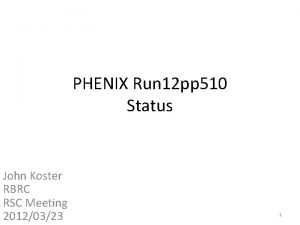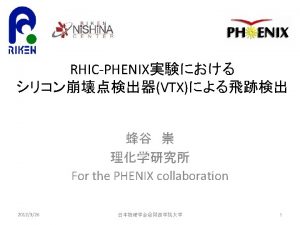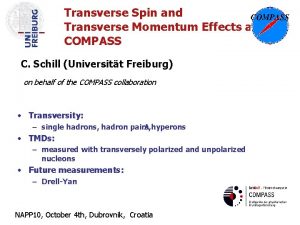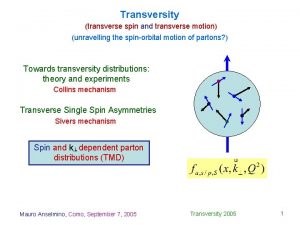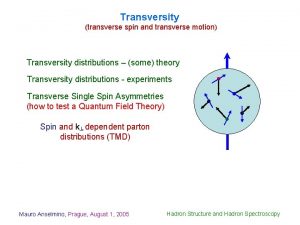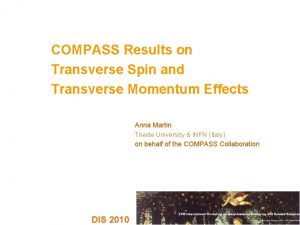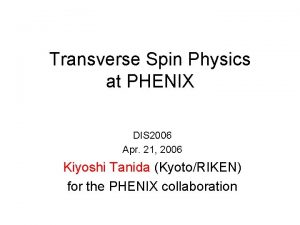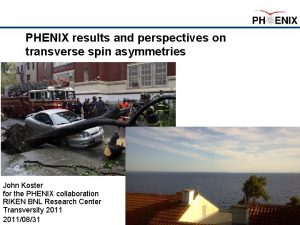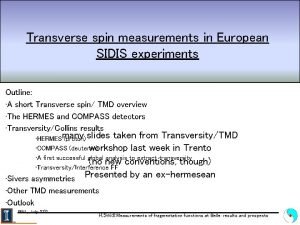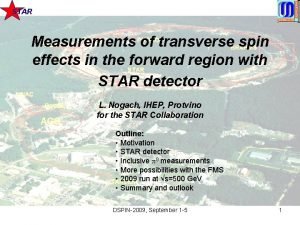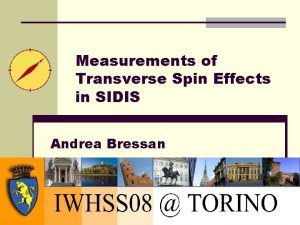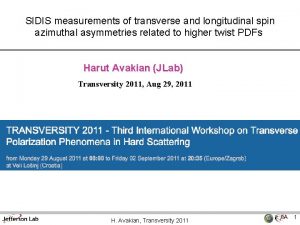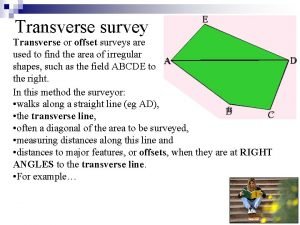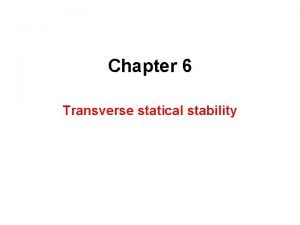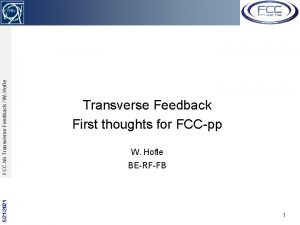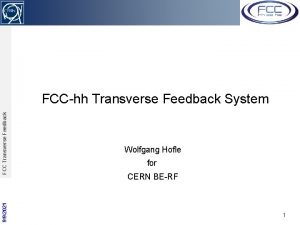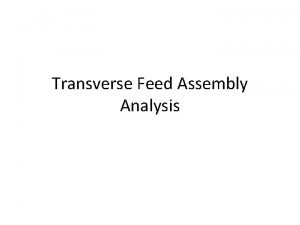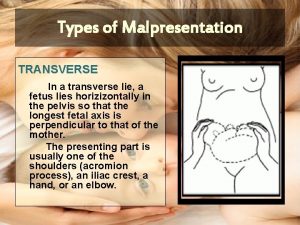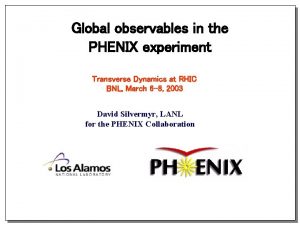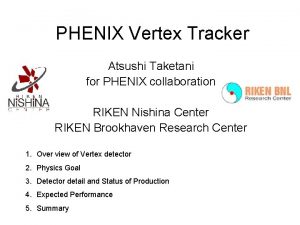Transverse Spin Measurements at PHENIX John Koster for





![RHIC ∫L* and Polarization Run Energy Polarization [Ge. V] [%] Longitudinal L [pb-1] LP RHIC ∫L* and Polarization Run Energy Polarization [Ge. V] [%] Longitudinal L [pb-1] LP](https://slidetodoc.com/presentation_image_h2/bb09fbd5dac240eac63b5454437c0dc5/image-6.jpg)




















- Slides: 26

Transverse Spin Measurements at PHENIX John Koster for the PHENIX collaboration University of Illinois at Urbana-Champaign DIS 2009/04/27 1

Single Transverse Spin Asymmetries in pp Collisions AN difference in cross-section between particles produced to the left and right Left Right E 704: Left-right asymmetries AN for pions: Theory Expectation: Small asymmetries at high energies π+ π0 (Kane, Pumplin, Repko, PRL 41, 1689– 1692 (1978) ) AN AN O(10 -4) Theory π- Experiment: (E 704, Fermi National Laboratory, 1991) AN O(10 -1) Measured x. F 2

Possible Origin of Large Single Spin Asymmetries h fa q FFq σ fb X’ Proton Structure Can initial and/or final state effects generate large transverse spin asymmetries? (AN ~10 -1) p. QCD small spin dependence fragmentation function 3

Transverse Spin Effects in p↑p Collisions (I) Transversity quark distributions and Collins fragmentation function E 704: Left-right asymmetries AN for pions: Correlation between proton & quark spin + spin dependant fragmentation function π+ π0 Quark transverse Collins FF spin distribution AN π- J. C. Collins, Nucl. Phys. B 396, 161 (1993) (II) Sivers quark-distribution Correlation between proton-spin and transverse quark momentum x. F Sivers distribution D. Sivers, Phys. Rev. D 41, 83 (1990) 4

RHIC Polarized Proton Collider RHIC p. C Polarimeters Absolute Polarimeter (H jet) Siberian Snakes PHOBOS BRAHMS & PP 2 PP Siberian Snakes Spin Flipper STAR PHENIX Spin Rotators Polarized Source 2009 Run: Partial Snake Strong Snake LINAC 200 Me. V Polarimeter BOOSTER Helical Partial Snake AGS Excellent performance during first 500 Ge. V run at RHIC ~10 pb-1 200 Ge. V run ongoing Rf Dipole AGS Internal Polarimeter AGS p. C Polarimeter 5
![RHIC L and Polarization Run Energy Polarization Ge V Longitudinal L pb1 LP RHIC ∫L* and Polarization Run Energy Polarization [Ge. V] [%] Longitudinal L [pb-1] LP](https://slidetodoc.com/presentation_image_h2/bb09fbd5dac240eac63b5454437c0dc5/image-6.jpg)
RHIC ∫L* and Polarization Run Energy Polarization [Ge. V] [%] Longitudinal L [pb-1] LP 4 [pb-1] - Transverse L [pb-1] 2002 200 15 - 2003 200 27 0. 35 1. 9 x 10 -3 - - 2004 200 40 0. 12 9 x 10 -3 - - 2005 200 49 (47) 3. 4 2 x 10 -1 0. 16 3. 5 x 10 -2 2006 200 57 (51) 7. 5 7. 9 x 10 -1 2. 7 7. 0 x 10 -1 2006 62 48 0. 08 4. 2 x 10 -3 0. 02 4. 6 x 10 -3 2008 200 46 - 5. 2 1. 1 x 100 2009 500 ~35 2009 200 - 0. 15 LP 2 [pb-1] 3. 4 x 10 -3 ~10 In progress Steadily increasing polarization and luminosity * integrated luminosity for PHENIX central arm 6

Neutral Pion Cross-Sections Experiment vs p. QCD Guzey et al, PLB 603, 173 (2004) Process Contribution to 0, η=0, s=200 Ge. V de Florian et al, PRD: 76, 094021 0 Cross-Sections at y = 0 Experiment vs Theory § √s=200 Ge. V (RHIC) Agreement § √s=19. 4 Ge. V (FNAL/E 704) Different § √s=62. 4 Ge. V (RHIC) Agreement More work needed to understand lower energies Bourrely et al, Eur. Phys. J. C 36: 371 -374, 2004 7

PHENIX Data at Mid-Rapidity Helps Constrain gluon Sivers Function Experimental Measurement at y~=0 AN PRL 95, 202001 (2005) p +p 0+X at s=200 Ge. V/c 2 Comparison of Exp. To Theory AN p. T (Ge. V/c) High statistics 2006+2008 data et coming. Anselmino al, Phys. Rev. D 74, 094011 Smaller statistical errors (factor 23 improvement for 0’s) p. T Possible • Cyan: Gluon Sivers Function at Higher positivity bound, no sea quark Sivers • Thick Red: Gluon Sivers parameterized to be 1 sigma from PHENIX 0 AN • Blue: Asymmetry from Sea quark Sivers at positivity bound 8 • Green: Asymmetry from Gluon Sivers for case of sea quark at positivity bound

PHENIX Detector at RHIC PHENIX strategy: Central Arms | η | < 0. 35 • Identified charged hadrons • Neutral Pions • Direct Photon • J/Psi • Heavy Flavor Measure several observables each sensitive to different transverse spin effects (i) Forward SSA Neutral Pions Muon Arms 1. 2 < | η | < 2. 4 Sivers • & Collins J/Psi • Unidentified charged hadrons • Heavy Flavor (ii) Transversity-type Asymmetries Interference Frag. Func. Analysis MPC 3. 1 < | η | < 3. 9 • Neutral Pion’s Asymmetries • Eta’s (iii) Sivers-type Heavy Flavor Back to Back Hadrons Pion AN for y~0 9

(i) Forward SSA AN 0 in MPC • η > 3. 5 < η < 3. 7 • • η 3. 1 < 3. 5 Forward asymmetries contain mixture of contributions from § Sivers § Transversity x Collins § Twist-3 PHENIX 0 results available for √s=62 Ge. V Coming soon from 2008 √s=200 Ge. V dataset – 0 and 5. 2 pb-1, 46% Polarization Process contribution to 0, =3. 3, s=200 Ge. V Asymmetries could enter a global analysis on transverse spin asymmetries 10 Guzey et al, PLB 603, 173 (2004)

(ii) Constraints on Transversity: Dihadron IFF Analysis IFF _ + + _ Interference Fragmentation Function Analysis Measure di-hadron asymmetry with hadron pairs in central arm ( 0, h+) ( 0, h-), (h+, h-) § Measures δq(x) x H 1 Transversity extraction will become possible with Interference Fragmentation Function (H 1 ) 11 measurement in progress at BELLE

Models for Interference Fragmentation Function § § Use partial wave analysis of phase shift data to model IFF Sign change around r mass Jaffe, Jin and Tang, PRL 80 (1998) 1166 § § Breit-Wigner shape for p wave No sign change around r mass Trend consistent with HERMES results Bacchetta and Radici, Phys. Rev. D 74, 114007 (2006) Analysis done in mass bins above and below the ρ mass 12

vs mass of the pair Added statistics from 2008 running NEW No significant asymmetries seen at mid-rapidity. 13

vs invariant mass of the pair Added statistics from 2008 running NEW No significant asymmetries seen at mid-rapidity. 14

(iii) Constraints on Sivers Function: Heavy Flavor D meson AN • Production dominated by gluon-gluon fusion at RHIC energy • Gluon transversity zero Asymmetry cannot originate from Transversity x Collins • Sensitive to gluon Sivers effect Theoretical prediction: p↑p DX Anselmino et al, Phys. Rev. D 70, 074025 (2004) Gluon Sivers=Max Quark Sivers=0 Gluon Sivers=0 Quark Sivers=Max 15

(iii) Constraints on Sivers Function: Heavy Flavor PHENIX: no reconstruction of D meson Exploratory measurements of AN for single muons Dominated by charm production in current kinematic range Predicted asymmetry smeared by decay kinematics 16

(iii) Constraints on Sivers Function: J/Psi Exploratory measurement of AN J/Psi §J/Psi production mechanism not well understood §Single spin asymmetries may shed light on production mechanism Constraints on gluon Sivers function Yuan, PRD 78: 014024, 2008 17

(iii) Constraints on Sivers Function: Di. Jet Production Azimuthal distribution of Di-Jet production in pp Suggested in: Boer, Vogelsang, Phys. Rev. D 69, 094025 Counts Proton Spin k. T δφ Beam is in and out of page Look at back-to-back jet opening angles δφ Sensitive to Sivers function only! No Collins-type effects 18

(iii) Constraints on Sivers Function: Di. Hadron Production pi 0 h+/- PHENIX Result from 2006 data: § Done with di-hadrons at y 1=y 2~=0 § Asymmetry consistent with zero Large 2008 data set available! Similar analysis possible in different combinations of rapidity ηmin ηmax -3. 7 -3. 1 -2. 0 -1. 4 -0. 35 +0. 35 1. 4 2. 0 3. 1 3. 9 Works in progress… 19

Summary § § Initial constraints on gluon Sivers function Dedicated transversity channels: – IFF Analysis – Future analysis with Collins asymmetry (See next slide) § Sivers function constraints possible with more data – Connection to orbital angular momentum? Near Term Outlook -- Large 2008 Dataset (i) Forward SSA AN 0 at √s=200 Ge. V soon. Exploring η, K 0 short, Direct γ (ii) Transversity-type measurements IFF results already preliminary Exploration Forward IFF (iii) Sivers-type measurements AN for y~0 smaller errors and higher p. T AN Heavy Flavor -- Forward open heavy flavor, J/Psi -- Mid-rapidity open heavy flavor Di-Jet analyses will expand to rapidity-separated hadron pairs 20

Long Term Outlook -- Upgrades § Vertex Detectors (2011 -2012) Large acceptance precision tracking – Heavy flavor tagging – Jets – Drell-Yan – Electrons from charm decays and beauty decays separately – c, b-Jet Correlations § Forward Calorimetery (2012 -2013) Proposed PHENIX Upgrade ( 1 < eta < 3 ) – AN 0, Direct γ, γ-Jet – Collins-type analyses 21

Backup 22

IFF: Definition of Vectors and Angles Bacchetta and Radici, PRD 70, 094032 (2004) 23

IFF: Transversity from di-hadron SSA Physics asymmetry Unpolarized quark distribution Known from DIS Transversity to be extracted Hard scattering cross section from p. QCD IFF + Di-hadron FF to be measured in e+e- 24

Ongoing IFF measurement at BELLE (RBRC/Illinois) j 2 - IFF sensitivity projection from data e- -j 1 e+ thrust axis Artru and Collins, Z. Phys. C 69, 277 (1996) Boer, Jakob, and Radici, PRD 67, 094003 (2003) 25

Models for IFF § § Use partial wave analysis of phase shift data to model IFF Sign change around r mass Jaffe, Jin and Tang, PRL 80 (1998) 1166 § § Breit-Wigner shape for p wave No sign change around r mass Trend consistent with HERMES results Bacchetta and Radici, Phys. Rev. D 74, 114007 (2006) 26
 What is a low spin complex
What is a low spin complex Spin-spin coupling examples
Spin-spin coupling examples Spin spin coupling
Spin spin coupling J coupling constant
J coupling constant Spin up spin down
Spin up spin down Lesser sac of peritoneum
Lesser sac of peritoneum Professional and social jargonisms
Professional and social jargonisms Le phenix de la famille meaning
Le phenix de la famille meaning Phenix scan
Phenix scan Phenix scan
Phenix scan René de koster
René de koster Nicole koster
Nicole koster Ingrid köster
Ingrid köster Tuberculosis pulmonar
Tuberculosis pulmonar “lamb” loeffler alkaline methylene blue
“lamb” loeffler alkaline methylene blue Europe 2020 targets
Europe 2020 targets Kontinuitetshantering i praktiken
Kontinuitetshantering i praktiken Novell typiska drag
Novell typiska drag Nationell inriktning för artificiell intelligens
Nationell inriktning för artificiell intelligens Ekologiskt fotavtryck
Ekologiskt fotavtryck Varför kallas perioden 1918-1939 för mellankrigstiden?
Varför kallas perioden 1918-1939 för mellankrigstiden? En lathund för arbete med kontinuitetshantering
En lathund för arbete med kontinuitetshantering Särskild löneskatt för pensionskostnader
Särskild löneskatt för pensionskostnader Tidbok för yrkesförare
Tidbok för yrkesförare Sura för anatom
Sura för anatom Vad är densitet
Vad är densitet Datorkunskap för nybörjare
Datorkunskap för nybörjare

